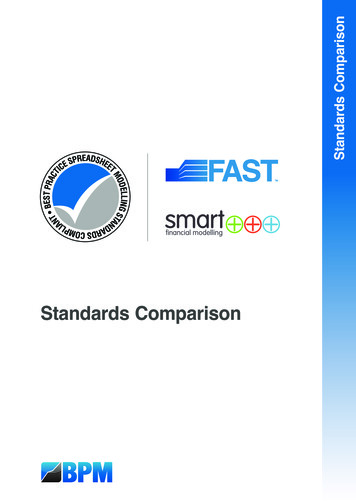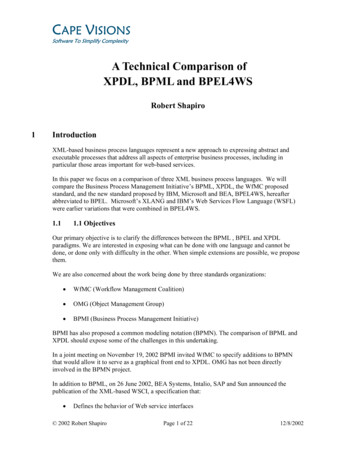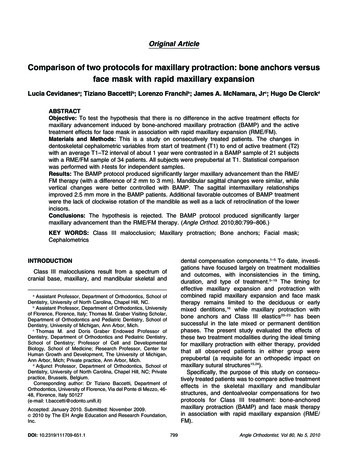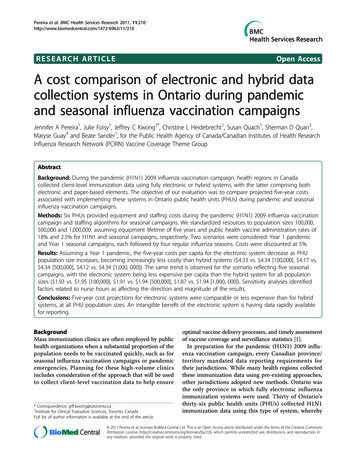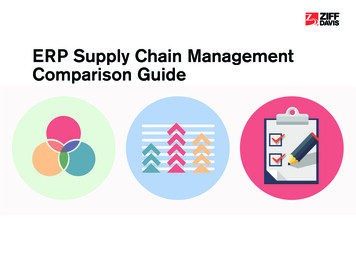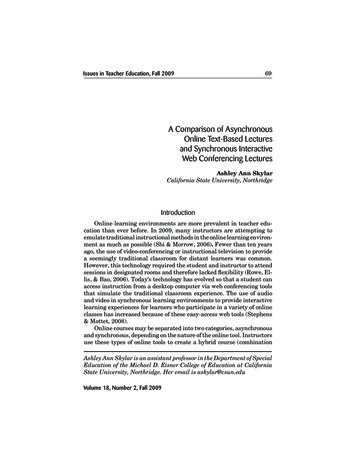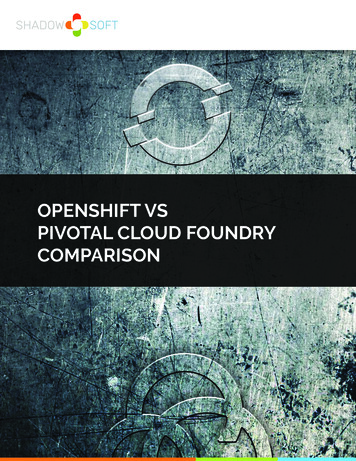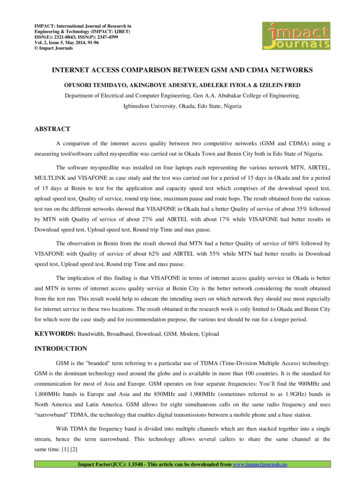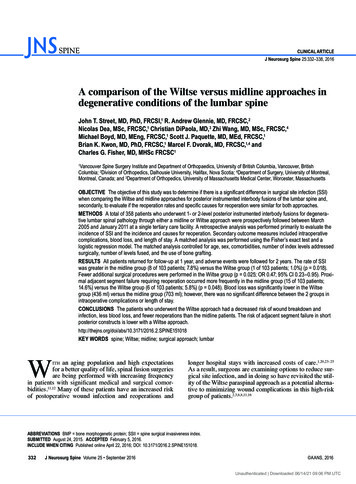
Transcription
clinical articleJ Neurosurg Spine 25:332–338, 2016A comparison of the Wiltse versus midline approaches indegenerative conditions of the lumbar spineJohn T. Street, MD, PhD, FRCSI,1 R. Andrew Glennie, MD, FRCSC,2Nicolas Dea, MSc, FRCSC,1 Christian DiPaola, MD,3 Zhi Wang, MD, MSc, FRCSC,4Michael Boyd, MD, MEng, FRCSC,1 Scott J. Paquette, MD, MEd, FRCSC,1Brian K. Kwon, MD, PhD, FRCSC,1 Marcel F. Dvorak, MD, FRCSC,1,4 andCharles G. Fisher, MD, MHSc FRCSC11Vancouver Spine Surgery Institute and Department of Orthopaedics, University of British Columbia, Vancouver, BritishColumbia; 2Division of Orthopedics, Dalhousie University, Halifax, Nova Scotia; 4Department of Surgery, University of Montreal,Montreal, Canada; and 3Department of Orthopedics, University of Massachusetts Medical Center, Worcester, MassachusettsObjective The objective of this study was to determine if there is a significant difference in surgical site infection (SSI)when comparing the Wiltse and midline approaches for posterior instrumented interbody fusions of the lumbar spine and,secondarily, to evaluate if the reoperation rates and specific causes for reoperation were similar for both approaches.Methods A total of 358 patients who underwent 1- or 2-level posterior instrumented interbody fusions for degenerative lumbar spinal pathology through either a midline or Wiltse approach were prospectively followed between March2005 and January 2011 at a single tertiary care facility. A retrospective analysis was performed primarily to evaluate theincidence of SSI and the incidence and causes for reoperation. Secondary outcome measures included intraoperativecomplications, blood loss, and length of stay. A matched analysis was performed using the Fisher’s exact test and alogistic regression model. The matched analysis controlled for age, sex, comorbidities, number of index levels addressedsurgically, number of levels fused, and the use of bone grafting.Results All patients returned for follow-up at 1 year, and adverse events were followed for 2 years. The rate of SSIwas greater in the midline group (8 of 103 patients; 7.8%) versus the Wiltse group (1 of 103 patients; 1.0%) (p 0.018).Fewer additional surgical procedures were performed in the Wiltse group (p 0.025; OR 0.47; 95% CI 0.23–0.95). Proximal adjacent segment failure requiring reoperation occurred more frequently in the midline group (15 of 103 patients;14.6%) versus the Wiltse group (6 of 103 patients; 5.8%) (p 0.048). Blood loss was significantly lower in the Wiltsegroup (436 ml) versus the midline group (703 ml); however, there was no significant difference between the 2 groups inintraoperative complications or length of stay.Conclusions The patients who underwent the Wiltse approach had a decreased risk of wound breakdown andinfection, less blood loss, and fewer reoperations than the midline patients. The risk of adjacent segment failure in shortposterior constructs is lower with a Wiltse SPINE151018KEY WORDS spine; Wiltse; midline; surgical approach; lumbarWan aging population and high expectationsfor a better quality of life, spinal fusion surgeriesare being performed with increasing frequencyin patients with significant medical and surgical comorbidities.11,12 Many of these patients have an increased riskof postoperative wound infection and reoperations andithlonger hospital stays with increased costs of care.1,20,23–25As a result, surgeons are examining options to reduce surgical site infection, and in doing so have revisited the utility of the Wiltse paraspinal approach as a potential alternative to minimizing wound complications in this high-riskgroup of patients.2,3,6,8,11,16ABBREVIATIONS BMP bone morphogenetic protein; SSII spine surgical invasiveness index.SUBMITTED August 24, 2015. ACCEPTED February 5, 2016.include when citing Published online April 22, 2016; DOI: 10.3171/2016.2.SPINE151018.332J Neurosurg Spine Volume 25 September 2016 AANS, 2016Unauthenticated Downloaded 06/14/21 09:06 PM UTC
Wiltse vs midline approachThe Wiltse approach to the posterior lumbar spine wasfirst described in 1968. It was proposed as an alternatedirect approach to the facet joint and transverse process,rather than the conventional midline approach.34,35 As amuscle-splitting approach through the sacrospinalis muscle and between the multifidus and longissimus, the Wiltseapproach theoretically leads to less tissue destruction andblood loss and potentially improved postoperative pain.With time, the approach evolved to be applicable to multiple indications with a growing number of proposed advantages, including the facilitation of 2 surgeons workingconcurrently, more direct pedicle screw insertion trajectories, easier decompression of far lateral disc herniations,and a surgical trajectory that enables decompression of thecontralateral canal.7,36 One of the potential limitations ofthe Wiltse approach is that central decompression is technically more difficult to achieve, but this is overcome asone gains familiarity with the approach.30,31There are numerous studies that have evaluated theeffect of dissection time and extent of surgical retractionduring midline spine surgery on local muscle function,vascularity, and viability. Studies in animals and humanshave consistently shown that prolonged paraspinal muscleretraction predisposes patients to increased pain and ahigher degree of tissue necrosis and puts them at a potentially greater risk of infection.2,9,10,18 Methods for minimizing soft-tissue injury have been proposed. Minimallyinvasive technologies have taken advantage of the paraspinal approach by way of percutaneous access points.In this study, we compared the paraspinal Wiltse approach to the standard posterior midline approach in patients who underwent 1- or 2-level decompression with interbody fusion of the lumbar spine. The primary objectivewas to determine the difference in the rates of postoperativesurgical site infection through a rigorous matched analysis.Secondary objectives included comparing the reoperationrates and evaluating the specific causes for reoperation.MethodsStudy DesignA retrospective cohort of consecutive patients with prospectively collected data who were admitted for surgicalmanagement of degenerative lumbar spine conditions wereidentified and enrolled between March 2005 and January2011. Only patients with a full data complement over a2-year follow-up period were included. Our methods forprospectively collecting adverse event data have beenpreviously published.19,27,28 All patients underwent decompression and pedicle screw instrumentation through eithera standard midline or Wiltse approach. The standard technique with either approach at our institution is to performa complete facetectomy of at least 1 of the facets and insert the interbody cage through the foramen (transforaminal lumbar interbody fusion) while visualizing and protecting the exiting and traversing nerve roots. All patientshad an interbody device inserted. Patients underwent acomplete laminectomy if a midline approach was used,or a full laminectomy if a Wiltse approach was chosen.A standard Wiltse interval through the longissimus andmultifidus was used, and the facet joint capsule was ex-posed. After pedicle screw instrumentation, the facet jointwas removed/osteotomized. If further central decompression was required, the soft tissues were dissected off thelamina more medially to allow for bilateral laminectomyand flavectomy while carefully protecting the dura anddisplacing the cauda contents ventrally. A full central decompression was achieved with this approach.Those patients included for analysis had a primary diagnosis of degenerative lumbar pathology with instability (degenerative/isthmic spondylolisthesis or anticipatedintraoperative facet resection) and required a 1- or 2-levelinstrumented fusion. Patients were excluded if they had atraumatic spinal injury, tumor, or preoperative neurological deficit or required noninstrumented fusion or greaterthan 2-level fusion. A 2% chlorhexidine with isopropylalcohol skin preparation was used on all patients preoperatively at 1 day before their operation and immediatelypreoperatively. Standard antibiotic prophylaxis was alsoused in all patients.Patient OutcomesPatient age, sex, prior spine surgery, and medical comorbidities were recorded preoperatively using a standardized format. Patients were categorized into 1 of 5 agegroups for the purposes of this analysis (age ranges 17–44,45–54, 55–64, 65–74, and 75 years). These categories facilitated comparisons between more comparable patientswith roughly equal numbers in each group. The total operative time and intraoperative and postoperative blood losswere recorded by a blinded observer. The number of levels fused, bone graft type/bone graft substitute, and incidence of intraoperative adverse events (e.g., unintentional/incidental durotomy, hardware malposition requiring revision) were recorded. Bone morphogenetic protein (BMP)(Medtronic) was used at the surgeons’ discretion.13,33 Thelength of stay in the hospital was calculated for both groupsbased on the day of admission and discharge. Finally, thespine surgical invasiveness index (SSII) was calculatedfor both groups to ensure that any treatment heterogeneitybased on the diagnosis was accounted for by comparingsimilar cases in terms of their risk of infection. SSII wasreported to ensure that each group was comparable basedon the complexity of the surgical case, and SSII representsthe best predictor for risk of infection.4,22All study patients were evaluated clinically and radiographically at 3, 6, and 12 months following surgery. Allclinical encounters for 2 years were included in the dataanalysis of this study. Our referral/re-referral patterns andgeographic demographics are such that all subsequentclinical encounters would have presented back to our quaternary care center. Surgical site infection and the needfor a repeat surgical procedure were recorded throughoutthe study period. Infection was recorded using the definition of the Centers for Disease Control and Prevention.14 Awound infection was documented by positive intraoperative cultures and demonstrated erythematous skin changesand purulent discharge. A wound complication includedwound dehiscence without positive intraoperative cultures with minimal erythema or discharge. When repeatsurgery was needed during the study period, fusion wasassessed radiographically or intraoperatively by the directJ Neurosurg Spine Volume 25 September 2016333Unauthenticated Downloaded 06/14/21 09:06 PM UTC
J. T. Street et al.observation of any fusion mass present and mechanicalmanipulation of the surgical levels.17Statistical AnalysisThe statistical analysis was performed using the SPSSstatistical software package (version 22.0; SPSS). We performed a matched analysis since we expected to find differences in patient characteristics between approaches. Toensure a more robust comparison, we controlled for potential confounders and analyzed the data using the Fisher’sexact test, odds ratios, and 1-sided p values.For the matched analysis, 1 midline patient was matchedto 1 Wiltse patient based on sex, age group at admission(17–44, 45–54, 55–64, 65–74, or 75 years), preoperativecomorbidities (diabetes, other, or none), number of indexoperative levels (1, 2, or 3), number of instrumented vertebral levels (1 or 2), and bone graft used (autograft only,autograft and synthetic autograft [i.e., not BMP], or BMP/BMP only/none).For the secondary analysis, a logistic regression modelcomparing the odds of an additional admission requiringrepeat surgery versus the approach (midline or Wiltse)was performed. This was also done to control for as manyvariables as possible in a matched fashion. Finally, a tertiary analysis evaluating the reasons for reoperation wasperformed.ResultsA total of 358 patients were included in the final analysis. No patients were lost to follow-up at 1 year, and the adverse event and reoperation data were collected for a totalof 2 years after the index procedure. Two hundred fifty-fivepatients underwent a midline approach, and 103 patientsunderwent bilateral Wiltse approaches. The most commonindications for surgery were isthmic spondylolisthesis anddegenerative spondylolisthesis. Table 1 lists the completediagnostic details and primary surgical indications for allmidline and Wiltse patients. There was a statistically significant difference in patient age, with the Wiltse groupbeing younger by approximately 5 years (Wiltse 54.6years vs midline 59.6 years; p 0.002). Wiltse patientsdiffered in terms of the number of levels addressed surgically, in addition to the number of instrumented levels,demonstrating a significantly higher number of 1-levelsurgeries. Only 1-level surgery was performed in 81 of 103Wiltse patients (78.6%), whereas midline surgeries tendedto address more vertebral levels; only 154 of 255 (60.4%)TABLE 1. Distribution of various pathologies addressed byapproach*DiagnosisMidline(n 255)Wiltse(n 103)Isthmic spondylolisthesisDegenerative spondylolisthesisSpinal stenosis w/o spondylolisthesisDisc protrusionsOther55 (21.6)134 (52.5)40 (15.7)16 (6.3)10 (3.9)54 (52.4)35 (34.0)5 (4.9)8 (7.8)1 (1.0)* Values are presented as the number of patients (%).334patients underwent 1-level instrumented surgery as the index procedure (p 0.001).BMP augmented with a local autograft was used significantly more often in the Wiltse group (60.2%) than inthe midline group (43.9%) (p 0.0001). Midline patientsalso relied on local autograft alone (46.3%) for a greatermajority of cases (p 0.0001). No other differences existed with regard to using BMP alone or another syntheticbone graft (Table 2). A mixture of BMP and local bone autograft was placed within the interbody device and alongthe transverse processes after decortication. There wereno significant differences in the use of iliac crest bonegraft between the groups (p 0.865).There was no difference in the mean length of the procedure, with midline surgeries lasting roughly 4.1 hoursand Wiltse surgeries lasting 3.9 hours (p 0.263). Intraoperative blood loss was significantly lower in the Wiltsegroup (average 436 ml), whereas the midline group loston average 703 ml (p 0.001). The incidental durotomyrate was the same for each group (4.5% midline vs 4.9%Wiltse; p 0.805). The average length of stay for midline patients was 1.5 days longer than the Wiltse group.Although this finding is clinically significant, it was notfound to be statistically significant (p 0.069). There wasno significant difference in patients requiring a repeatsurgery during their hospital stay for infection, hardwaremalposition, or pseudomeningocele (p 0.363). Table 3details all variables that were compared and demonstratesthat there were no other significant differences when comparing approaches. The groups were similar in terms ofcomplexity, and SSII was 10.74 2.63 for the Wiltse groupand 10.54 2.72 for the midline group.To additionally control for these differences, a matchedanalysis was then performed. It was possible to match 66%of the cohort for all 6 possible confounding variables, and85.5% of the cohort was matched for 5 or more variables(sex, age, preoperative comorbidities, number of index operative vertebral levels, number of instrumented vertebrallevels, and bone graft used). For example, 85.5% of patientswere matched for sex, age, preoperative comorbidities,number of index operative vertebral levels, and number ofinstrumented vertebral levels, but 15% of patients could notbe matched with respect to the type of bone graft used.Case-control analysis of the matching cohorts revealeda lower infection rate in the Wiltse group (1 of 103 patients; 1.0%) in comparison with the midline group (8 of103 patients; 7.8%) (p 0.018). The odds ratios for each ofthe control variables are shown in Table 4.Patients who underwent the Wiltse approach demonTABLE 2. Distribution of patients who received bone graft orbone graft substitute to promote fusion*Bone GraftMidlineWiltseAutograft onlyAutograft & synthetic (no BMP)Autograft & BMPBMP only118 (46.3)12 (4.7)112 (43.9)12 (4.7)25 (24.3)†2 (1.9)62 (60.2)†13 (12.6)* Values are presented as the number of patients (%).† Significant at p 0.0001.J Neurosurg Spine Volume 25 September 2016Unauthenticated Downloaded 06/14/21 09:06 PM UTC
Wiltse vs midline approachTABLE 3. Detailed comparisons between each techniqueVariableSexMaleFemaleAge at admission, yrsPrevious spine surgeryYesNoNo. of index procedure vertebral levels234No. of index procedure instrumented vertebral levels23Iliac crest bone graft usedYesNo 1 surgery required during stayYesNoCSF leakage/dural tearYesNoAdditional admission requiring repeat surgeryYesNoIntensive care unit stayYesNoRecoded comorbidities (diabetes, other)YesNoDistant-site infectionUrinary tract infectionBacteremiaPneumoniaNoneReadmission w/ infection after distant-site infectionYesNoLength of stay (days)Index procedure operative time (hrs)Index procedure blood loss 1703Statistical Test ComparingApproachesp ValueFisher’s exact test0.292Fisher’s exact testFisher’s exact test0.002*1.000Fisher’s exact test 0.001*Fisher’s exact test0.006*Fisher’s exact test0.865Fisher’s exact test0.363Fisher’s exact test0.805Fisher’s exact test0.006*Fisher’s exact test0.383Fisher’s exact test0.645Fisher’s exact test0.450Fisher’s exact test1.0002-sample t-test2-sample t-test2-sample t-test0.0690.263 0.001** Statistically significant at p 0.05.strated reduced odds (OR 0.47; 95% CI 0.23–0.95) of anadditional admission requiring repeat surgery comparedwith patients who underwent surgery through the midlineapproach.Adjacent-segment pathology differed with approach;15 of 103 (14.6%) midline patients required revision surgery within 2 years of the index procedure. This result wasagain statistically significant compared with the 6 of 103(5.8%) Wiltse patients who required a repeat operation foradjacent-level pathology (p 0.048) (Table 5).J Neurosurg Spine Volume 25 September 2016335Unauthenticated Downloaded 06/14/21 09:06 PM UTC
J. T. Street et al.TABLE 4. Odds ratios for the variables used in the matched analysisVariableWiltse vs midlineMale vs femaleAge group at admission in yrs (reference: 75 yrs)17–4445–6455–6465–74Recoded comorbidity (reference: none)DiabetesOther2 index procedure vertebral levels vs 3 & 4 levels2 index procedure instrumented vertebral levels vs3 levelsRecoded index procedure bone graft (reference:BMP only)Autograft onlyAutograft & synthetic (not BMP)Autograft & BMPDiscussionMatchedOR (95% CI)0.47 (0.23–0.95)1.37 (0.79–2.38)0.35 (0.12–1.02)0.37 (0.13–1.05)0.46 (0.18–1.17)0.68 (0.28–1.64)0.55 (0.21–1.41)0.75 (0.37–1.52)0.45 (0.10–2.08)1.20 (0.26–5.56)0.78 (0.23–2.61)0.73 (0.12–4.38)1.06 (0.33–3.44)We present the largest study comparing the Wiltse approach to the more conventional midline approach fordecompression and fusion of the degenerative lumbarspine. Matched analysis revealed significant differencesin complications when comparing these approaches. Wehave identified several advantages of the Wiltse approach,including lower infection risk, shorter hospital stay, fewerreadmissions requiring surgery, and a lower risk of reoperation, specifically for adjacent-segment pathology within 3years of the index surgery.The potential to reduce the infection rate from 7.8% to1.0% is statistically and clinically significant and has tremendous implications for optimizing infection preventionfor 1- and 2-level fusion surgeries of the degenerative lumbar spine. By controlling for sex, age, preoperative comorbidities, number of instrumented vertebral levels, and theuse of bone grafting, there is addition
clinical article J neurosurg Spine 25:332–338, 2016 W ith an aging population and high expectations for a better quality of life, spinal fusion surgeries are being performed with increasing frequency in patients with significant medical and surgical comor-Cited by: 11Publish Year: 2016Author: John T Street, R Andrew Glennie, Nicolas Dea, Christian DiPaola, Zhi W
